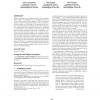3206 search results - page 548 / 642 » How minds can be computational systems |
P2P
2003
IEEE
15 years 3 months ago
2003
IEEE
Recent developments in the area of peer-to-peer computing show that structured overlay networks implementing distributed hash tables scale well and can serve as infrastructures fo...
SASO
2008
IEEE
15 years 4 months ago
2008
IEEE
—When programming a spatial computing medium such as a cellular automaton, the hop count distance to some set of sources (particles) is an often used information. In particular, ...
ATAL
2007
Springer
15 years 4 months ago
2007
Springer
Making commitments, e.g., through promises and threats, enables a player to exploit the strengths of his own strategic position as well as the weaknesses of that of his opponents....
102
click to vote
CIKM
2005
Springer
15 years 3 months ago
2005
Springer
Data mining techniques frequently find a large number of patterns or rules, which make it very difficult for a human analyst to interpret the results and to find the truly interes...
160
click to vote
Publication
he significant increase in the available computational power that took place in recent decades has been accompanied by a growing interest in the application of the evolutionary ap...

